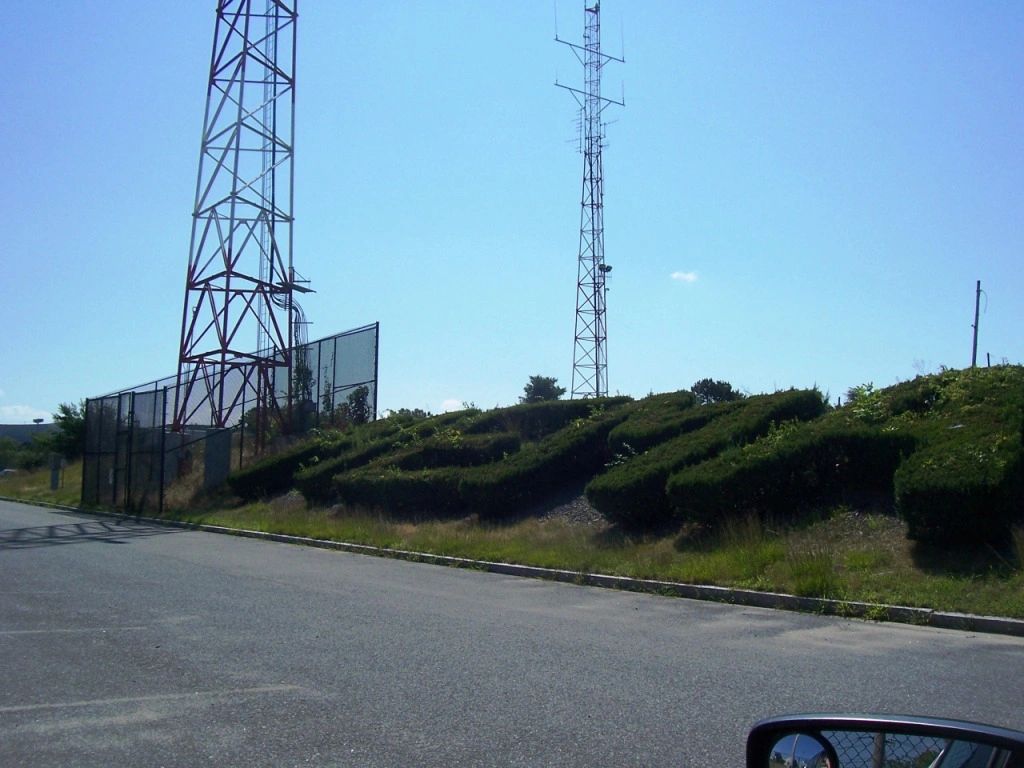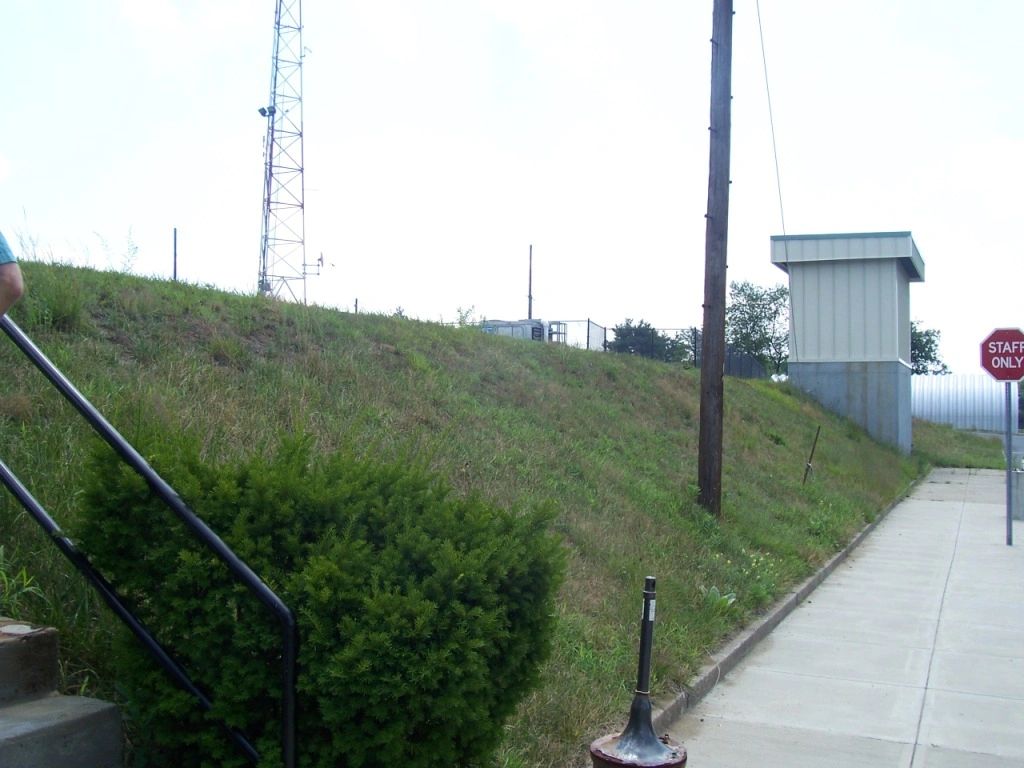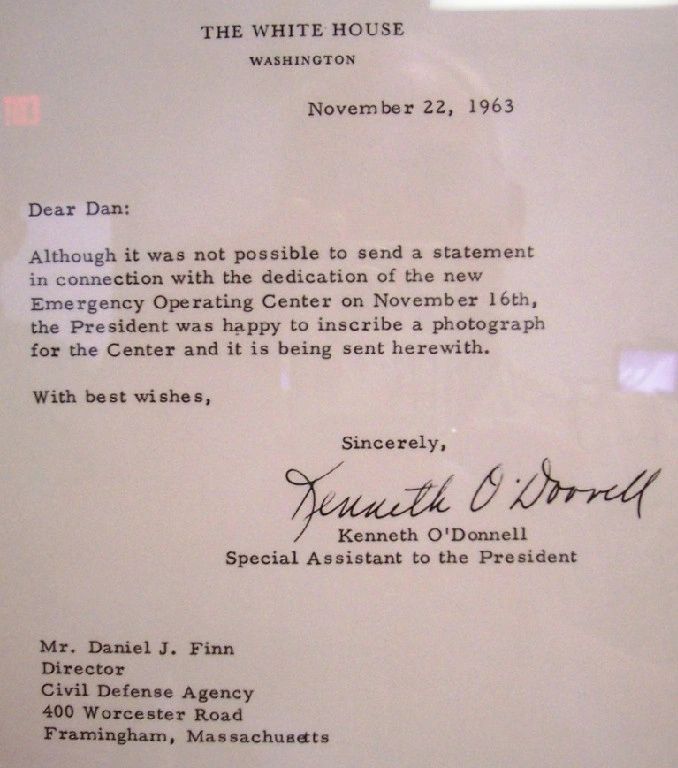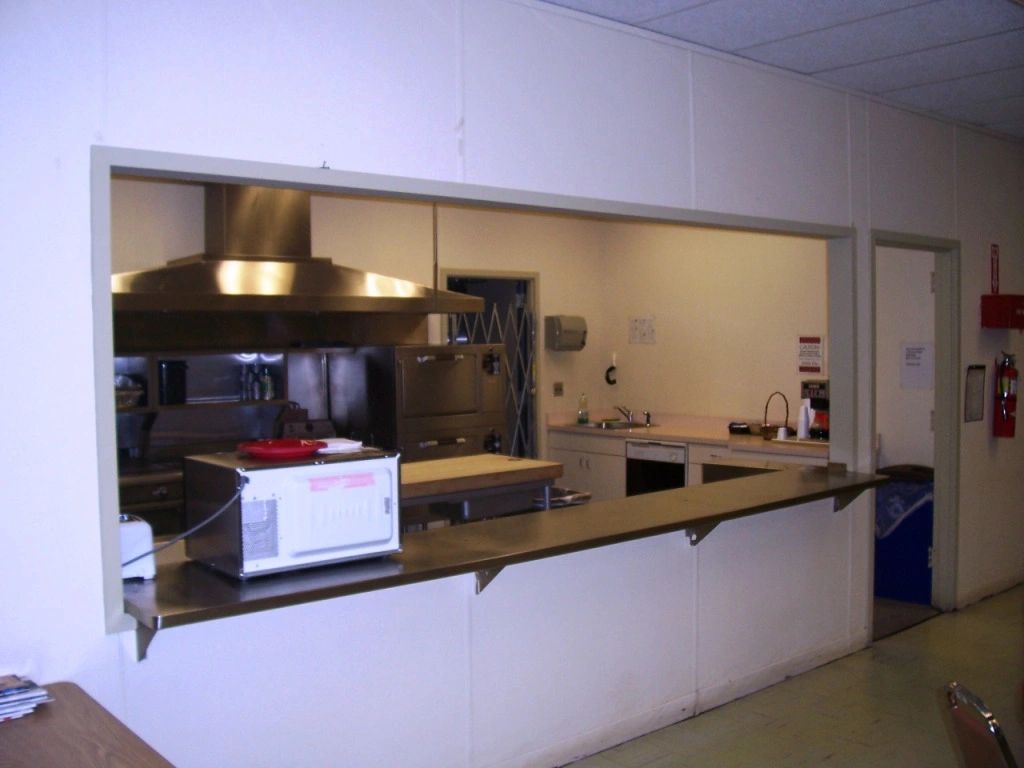MEMA Bunker

The Massachusetts Emergency Management Agency is headquartered in a cold-war era bunker in Framingham, MA.
http://www.civildefensemuseum.com/index.html
During the early 1960s, President John Kennedy devised a plan for each state to have a facility to ensure continuity of state government following a nuclear attack. Massachusetts was the first in the nation to have an underground blast-proof State Emergency Operations Center.
The location chosen for the SEOC, Framingham, was far enough away from Boston to be what was considered to be safe, but close enough to be reached quickly thanks to the Mass Turnpike.
The Massachusetts Emergency Management Agency Headquarters is about one acre in size. It was designed to protect 300 key state government officials, including the Governor in time of war. The State Emergency Operations Center (SEOC) is located 30-40’ below the ground and both entrance ramps were constructed at varied lengths and at right angles in order to provide protection from radioactive fallout. It was constructed to withstand a 20-megaton bomb exploding as close as three miles from its location, with outer walls of reinforced concrete, varying in thickness from 18 to 24 inches. The steel-plated blast doors are 82” high, 76” wide and 9” thick, and weigh 5,695 lbs.
The roof is comprised of 2 feet of high pressure concrete, covered by yards of compacted earth and a black-topped parking area. The entire structure was built to withstand an equivalent static pressure of 30 lbs per square inch. Under this type of shock, the entire building is designed to move about ½ foot horizontally and about 1 foot vertically. To withstand ground movements, such as a shock wave, following a nuclear blast (or an earthquake strike with the magnitude of 6.0 on the Richter Scale), all key mechanical and electrical equipment is mounted on vibration isolators, which support the equipment near its center of gravity, so if the floor tilts, the equipment remains level. Flexible joints connect the equipment to pipes and ducts that are firmly attached to the structure. Copper piping was installed to reduce the risk of shattering. All plumbing fixtures are stainless steel.
The facility was never intended to be a ‘Public Fallout Shelter’. It was capable of operating self sufficiently for 30 days. It had its own heating, ventilating and lighting plant, two 40 foot deep water wells, food storage, cafeteria, an all-electric kitchen, dry storage areas, freezers, sleeping facilities and a two-space morgue (since it was determined that if the facility was activated for 30 straight days, at least 2 of the 300 people staffing the SEOC would die of natural causes). Three 250kw-diesel generators provide triple-redundant auxiliary power.
The new Civil Defense Headquarters was constructed at a cost of $2.5 million, half of which were federal dollars. It was also built to be the Commonwealth’s Center of Communication, housing the Emergency Broadcast System. All radio and television broadcasting in Massachusetts would originate 24-hours a day during a national or statewide emergency. This ‘station’ was to be staffed by members of the Boston Media.
It was truly a state-of-the-art facility.
The Headquarters was dedicated on Saturday, November 16, 1963. President Kennedy was invited, but unable to attend, sent his regrets. Hanging in the Headquarters’ lobby is that letter of regret, which was written by his aide Ken O’Donnell. Ironically, the date of the letter is ‘November 22, 1963’, the date of President Kennedy’s assassination.
On the day of the dedication, Governor Endicott Peabody, who addressed the crowd of almost 3,000, later toured his new underground emergency office, which was set aside for the Commonwealth’s chief official. Other speakers that day included State Director of Civil Defense Daniel J. Flynn, U.S. Assistant Secretary of Defense for Civil Defense Stuart L. Pittman, Regional Director of Civil Defense Alexander A. Morrissette, as well as local Framingham officials and clergy. There were high school bands and the Framingham American Legion presented the colors.
The highlight of the day was reported to be when the two back-up hydraulically operated telescopic antennae, which are stored in 18-foot underground silos, were extended to their full height of 77’.
To quote briefly from the remarks made by Governor Endicott Peabody on that day: “To the Pilgrims, Civil Defense meant a blunderbuss, in addition to the stockade; a reliable warning system; a leader to turn to for direction and a pooling of resources for survival. What began in Plymouth has become an American tradition. It was exemplified in Paul Revere and the Minutemen and later in the Westward Movement. The will to survive has characterized America’s growth and greatness. The banding together for protection and assistance in times of peril has made us strong.”
These principles continue to hold true today, more than ever. Civil Defense, now Emergency Management, is more than the facilities and the equipment, but people. Men and women, who, for well over a half-century, have dedicated themselves to the safety and well-being of their fellow citizens, regardless of the danger, emergency or disaster.
See our companion site covering the Cold War history of Massachusetts
http://coldwar-ma.com

The Massachusetts Emergency Management Agency is headquartered in a cold-war era bunker in Framingham, MA.
http://www.civildefensemuseum.com/index.html
During the early 1960s, President John Kennedy devised a plan for each state to have a facility to ensure continuity of state government following a nuclear attack. Massachusetts was the first in the nation to have an underground blast-proof State Emergency Operations Center.
The location chosen for the SEOC, Framingham, was far enough away from Boston to be what was considered to be safe, but close enough to be reached quickly thanks to the Mass Turnpike.
The Massachusetts Emergency Management Agency Headquarters is about one acre in size. It was designed to protect 300 key state government officials, including the Governor in time of war. The State Emergency Operations Center (SEOC) is located 30-40’ below the ground and both entrance ramps were constructed at varied lengths and at right angles in order to provide protection from radioactive fallout. It was constructed to withstand a 20-megaton bomb exploding as close as three miles from its location, with outer walls of reinforced concrete, varying in thickness from 18 to 24 inches. The steel-plated blast doors are 82” high, 76” wide and 9” thick, and weigh 5,695 lbs.
The roof is comprised of 2 feet of high pressure concrete, covered by yards of compacted earth and a black-topped parking area. The entire structure was built to withstand an equivalent static pressure of 30 lbs per square inch. Under this type of shock, the entire building is designed to move about ½ foot horizontally and about 1 foot vertically. To withstand ground movements, such as a shock wave, following a nuclear blast (or an earthquake strike with the magnitude of 6.0 on the Richter Scale), all key mechanical and electrical equipment is mounted on vibration isolators, which support the equipment near its center of gravity, so if the floor tilts, the equipment remains level. Flexible joints connect the equipment to pipes and ducts that are firmly attached to the structure. Copper piping was installed to reduce the risk of shattering. All plumbing fixtures are stainless steel.
The facility was never intended to be a ‘Public Fallout Shelter’. It was capable of operating self sufficiently for 30 days. It had its own heating, ventilating and lighting plant, two 40 foot deep water wells, food storage, cafeteria, an all-electric kitchen, dry storage areas, freezers, sleeping facilities and a two-space morgue (since it was determined that if the facility was activated for 30 straight days, at least 2 of the 300 people staffing the SEOC would die of natural causes). Three 250kw-diesel generators provide triple-redundant auxiliary power.
The new Civil Defense Headquarters was constructed at a cost of $2.5 million, half of which were federal dollars. It was also built to be the Commonwealth’s Center of Communication, housing the Emergency Broadcast System. All radio and television broadcasting in Massachusetts would originate 24-hours a day during a national or statewide emergency. This ‘station’ was to be staffed by members of the Boston Media.
It was truly a state-of-the-art facility.
The Headquarters was dedicated on Saturday, November 16, 1963. President Kennedy was invited, but unable to attend, sent his regrets. Hanging in the Headquarters’ lobby is that letter of regret, which was written by his aide Ken O’Donnell. Ironically, the date of the letter is ‘November 22, 1963’, the date of President Kennedy’s assassination.
On the day of the dedication, Governor Endicott Peabody, who addressed the crowd of almost 3,000, later toured his new underground emergency office, which was set aside for the Commonwealth’s chief official. Other speakers that day included State Director of Civil Defense Daniel J. Flynn, U.S. Assistant Secretary of Defense for Civil Defense Stuart L. Pittman, Regional Director of Civil Defense Alexander A. Morrissette, as well as local Framingham officials and clergy. There were high school bands and the Framingham American Legion presented the colors.
The highlight of the day was reported to be when the two back-up hydraulically operated telescopic antennae, which are stored in 18-foot underground silos, were extended to their full height of 77’.
To quote briefly from the remarks made by Governor Endicott Peabody on that day: “To the Pilgrims, Civil Defense meant a blunderbuss, in addition to the stockade; a reliable warning system; a leader to turn to for direction and a pooling of resources for survival. What began in Plymouth has become an American tradition. It was exemplified in Paul Revere and the Minutemen and later in the Westward Movement. The will to survive has characterized America’s growth and greatness. The banding together for protection and assistance in times of peril has made us strong.”
These principles continue to hold true today, more than ever. Civil Defense, now Emergency Management, is more than the facilities and the equipment, but people. Men and women, who, for well over a half-century, have dedicated themselves to the safety and well-being of their fellow citizens, regardless of the danger, emergency or disaster.








Blast valves protect the air intakes from the overpressure from a nuclear detonation.









Reception area. Decontamination showers are just outside this door.


 Letter from the White House explaining why President Kennedy wasn't able to attend the dedication of the facility
Letter from the White House explaining why President Kennedy wasn't able to attend the dedication of the facility
written the date JFK was shot!





Communications duty station.

The facility includes an Amateur Radio Staiton capable of worldwide communication.

Seabrook Station alerting phone.

Huge water tanks.

Two person morgue.

State and national alarms.

Two of the three emergency power generators.



One of three emergency power generators.


Press room.

Cafeteria kitchen.

Former sound proofed Emergency Broadcast System studio, now used as an office.

Present day Emergency Operations Center has positions for military, state PD, National Weather Service, State Homeland Security, Dept of Transportation, Public Works, Health Department, Civil Air Patrol, etc.

Vintage photo of the Emergency Operations Center in action.


Male dormitory.

Large antenna towers provide state wide communications.











